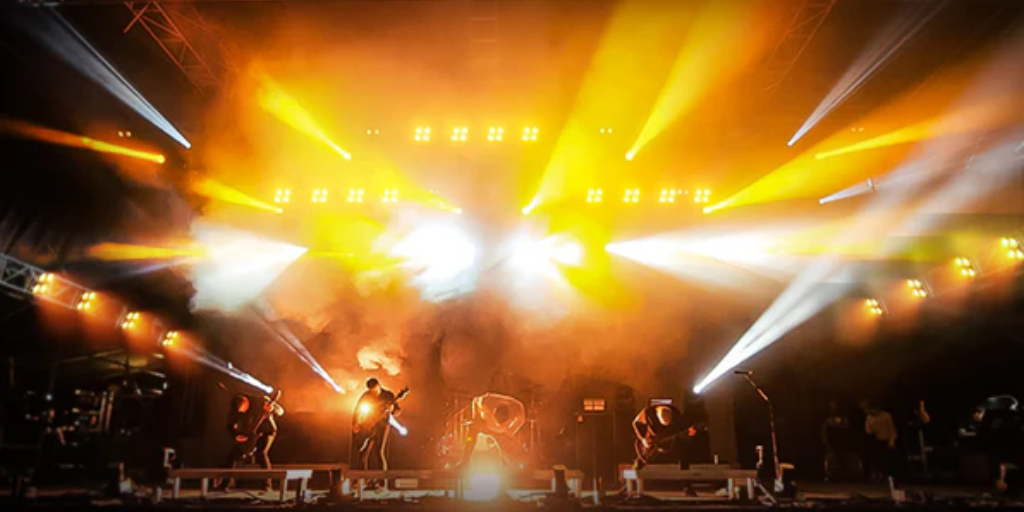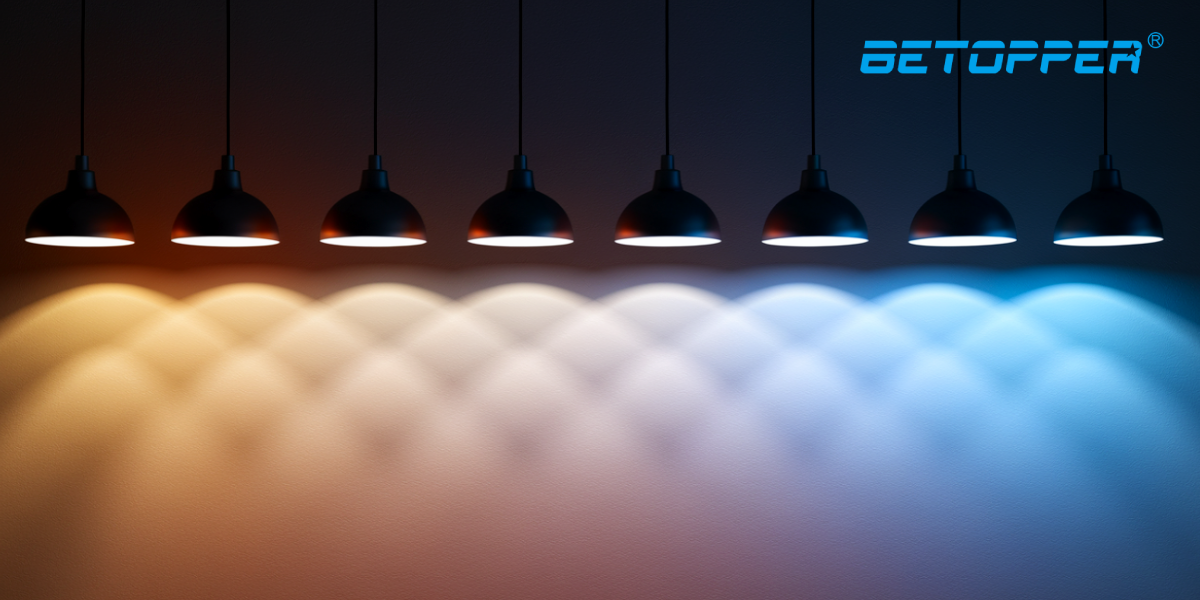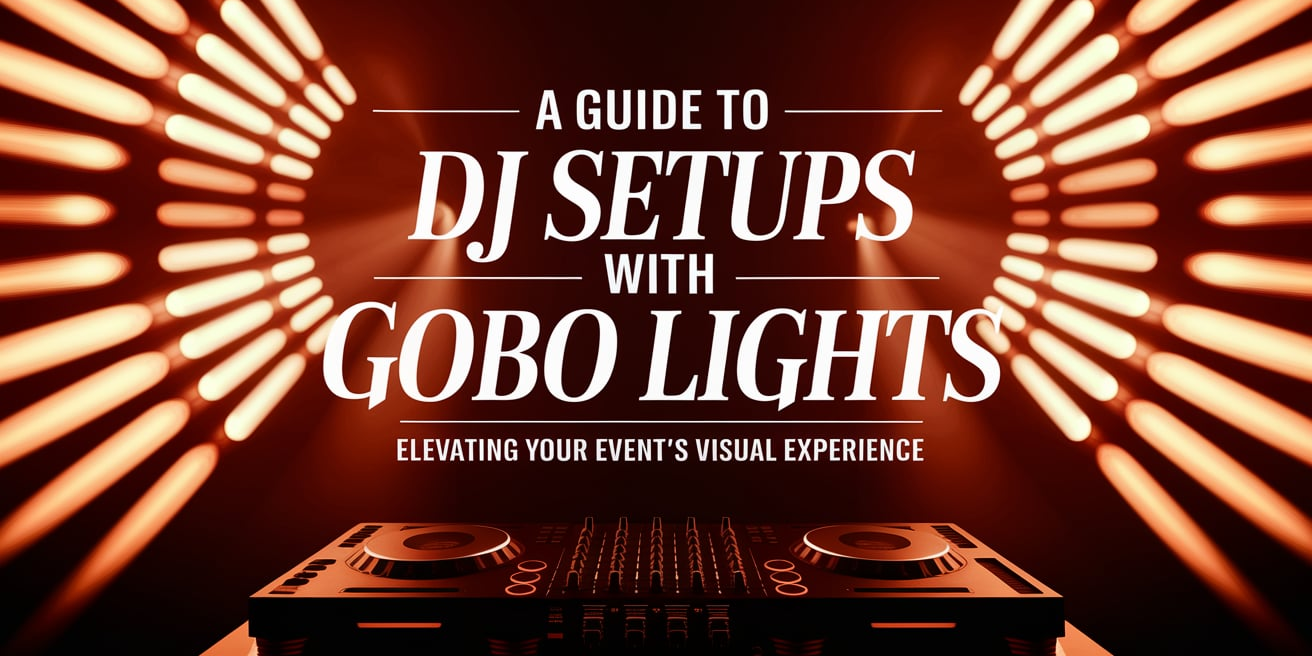Les blinders sont une source lumineuse puissante, dirigée directement vers le public et produisant des éclairs soudains. Ils visent à attirer visuellement le public, à le rendre plus présent et à créer un impact émotionnel. Découvrons ce qui les motive et comment ils ont évolué au fil du temps.
Dans ce guide, nous expliquerons en détail leur principe de fonctionnement, les différents types et leur importance pour la performance. Poursuivez votre lecture !
Que sont les lumières Stage Blinder ?
Un projecteur de scène est un dispositif d'éclairage haute intensité conçu pour créer des effets visuels spectaculaires lors de concerts, de théâtres et d'événements. Ces projecteurs produisent des éclairs synchronisés et intenses, souvent dirigés vers le public pour amplifier l'énergie et l'engagement.
Les éclairages blinder modernes utilisent la technologie LED, qui garantit une efficacité énergétique optimale, des couleurs éclatantes et des transitions rapides. Les éclairages blinder de scène sont ces outils mystérieux utilisés en coulisses pour créer des moments exceptionnels lors des spectacles.
Composants clés des lumières Blinder
1. Source lumineuse (LED ou halogène)
Le cœur de tout éclairage blinder réside dans sa source lumineuse. Les blinders modernes utilisent principalement des lampes à haute puissance. LED COB (Chip-on-Board), offrant des rendements lumineux dépassant souvent 10 000 lumens par cellule, avec une meilleure efficacité énergétique et une meilleure gestion de la chaleur que les lampes halogènes PAR traditionnelles (généralement 650 W ou 1 000 W par lampe). Les LED offrent également une durée de vie plus longue, jusqu'à 50 000 heures.
2. Système optique (réflecteurs et lentilles)
Pour concentrer et diriger la lumière intense vers le public, les blinders intègrent des réflecteurs paraboliques et parfois des lentilles de diffusion ou des modeleurs de faisceau. Ces composants contrôlent la diffusion du faisceau. et assure un lavage uniforme sur de grandes surfaces sans points chauds.
3. Interface de contrôle (options DMX et manuelles)
Les projecteurs Blinder sont généralement compatibles DMX512, permettant un contrôle précis à distance de l'intensité, du stroboscope et des séquences de poursuite. De nombreux modèles sont équipés de ports DMX à 3 ou 5 broches, et les modèles plus récents incluent également des options RDM (Remote Device Management) et DMX sans fil pour une flexibilité de configuration avancée.
4. Boîtier et matériel de montage
Les oeillères professionnelles utilisent des boîtiers en alliage d'aluminium durables, souvent dotés d'une protection IP (e.g., IP65) pour une utilisation en extérieur. Des étriers de montage intégrés, des supports Omega et des verrous de sécurité permettent une fixation sécurisée aux structures, aux planchers ou aux bords verticaux de la scène. Une gestion thermique (dissipateurs thermiques ou ventilateurs) est également intégrée pour protéger les composants internes.
Types de lumières de scène Blinder
Les éclairages de scène Blinder existent en différents modèles, chacun adapté à des événements et des effets spécifiques. Des LED écoénergétiques aux modèles d'extérieur résistants aux intempéries, comprendre ces différents types vous aidera à choisir l'outil idéal pour éblouir votre public. Explorons les six principales catégories.
Lumières LED Blinder
On estime que les éclairages LED Blinder consomment jusqu'à 80 % moins d'énergie que les ampoules traditionnelles, ce qui témoigne de leur efficacité lumineuse. Ces éclairages fonctionnent grâce à des micropuces RGBW (Rouge-Vert-Bleu-Blanc) ou COB (Chip-on-Board). Leur consommation d'énergie est minimale, ce qui leur permet de changer de couleur instantanément, sans gel, processus lent.
Les LED offrent une polyvalence de couleurs exceptionnelle ; certains systèmes offrent des millions de nuances, ce qui les rend idéales pour les concerts nécessitant des changements d'ambiance rapides. De plus, elles émettent une chaleur minimale, réduisant ainsi les besoins de refroidissement de la salle.
Têtes mobiles
Ces projecteurs allient une luminosité éblouissante à un positionnement dynamique. Leurs moteurs permettent des mouvements panoramiques et inclinables, permettant aux opérateurs de balayer la scène avec leurs faisceaux ou de suivre les artistes dans les airs.Les modèles haut de gamme se synchronisent avec les contrôleurs DMX pour créer des traînées lumineuses synchronisées pendant les séquences de danse.
L’adaptabilité aux événements est une autre force. Têtes mobiles Ajustez l'angle du faisceau, des spots étroits aux larges faisceaux wash, pour une installation aussi bien dans les théâtres intimistes que dans les stades. Certains projecteurs intègrent des effets de prisme et des gobos rotatifs pour des projections texturées.
Canettes PAR traditionnelles
Traditionnel canettes PAR— abréviation de Parabolic Aluminized Reflector lights — étaient la norme dans l'industrie avant l'adoption généralisée de la technologie LED. Ces luminaires intégraient généralement des lampes halogènes telles que les PAR56 (300 W à 500 W) et PAR64 (500 W à 1 000 W), réputées pour leur faisceau puissant et chaleureux aux contours doux.
Caractéristiques principales :
- Types de lampes : PAR64 C'est le modèle le plus emblématique, largement utilisé dans les concerts et les théâtres. Il offre un angle de faisceau fixe, défini par le type de lampe utilisée.e.g., NSP pour spot étroit, WFL pour large inondation).
- Construction: Boîtiers cylindriques simples en aluminium avec optique interne minimale, s'appuyant sur le réflecteur et la lentille intégrés de la lampe.
- Contrôle des couleurs : Réalisé en utilisant filtres à gel, car les projecteurs PAR traditionnels sont des luminaires monochromes sans mélange de couleurs intégré.
- Inconvénients :
- Consommation d'énergie élevée (e.g., une lampe PAR64 de 1 000 W contre un équivalent LED de 300 W).
- Mise en forme limitée du faisceau.
- Durée de vie de la lampe courte (~750–2 000 heures selon l’utilisation et la stabilité de la tension).
Alors que les PAR LED modernes dominent en raison de leur efficacité et de leurs fonctionnalités de contrôle DMX, les PAR traditionnels restent utilisés pour leur ton chaud distinct, leur simplicité robuste et leur esthétique nostalgique, en particulier dans les styles vintage ou rock. scénographies.
Stores à lattes
Les Batten Blinders sont des luminaires multi-LED minces conçus pour un montage vertical ou horizontal. Les modèles classiques comportent 10 à 20 LED dans un cadre discret, idéal pour habiller des scènes ou des structures sans obstruer la vue.
Stroboscopes-Blinders hybrides
Les modèles hybrides allient effets aveuglants et fonction stroboscopique. Un design courant associe un tube stroboscopique blanc central à une face RVB, créant des motifs pulsés synchronisés avec les basses fréquences. Les clusters modulaires permettent aux concepteurs de créer des murs de lumière pour les festivals.
Ces appareils s'épanouissent dans des environnements à haute énergie comme les spectacles EDM, où des flashs rapides et des rafales aveuglantes améliorent le rythme.
Stores extérieurs classés IP
Conçus pour durer, les stores d'extérieur certifiés IP résistent à la pluie, à la poussière et aux variations de température. De nombreux modèles utilisent quatre LED COB de 100 W pour diffuser une lumière blanche chaude intense, même sous une pluie battante. Leurs températures de couleur réglables en font la solution idéale pour les jeux en extérieur nécessitant des changements d'ambiance subtils. Leurs ports DMX étanches et leurs boîtiers en aluminium garantissent leur fiabilité pour les festivals, les défilés ou les événements en bord de mer.
En adaptant les types de blinders aux besoins de votre événement, qu'il s'agisse d'efficacité énergétique pour les théâtres ou d'éclairage dynamique pour les concerts, vous pouvez créer des expériences visuelles inoubliables.
Applications créatives des lumières Blinder
Les lumières Blinder ne sont pas de simples outils, elles sont au cœur des événements en direct. Voici comment les professionnels les utilisent pour impressionner les foules et raconter des histoires grâce à la lumière :
Techniques d'engagement du public
C'est dans l'interaction avec la foule que les lumières Blinder brillent le plus. Voici comment les pros les utilisent :
Synchronisation avec la musique : Imaginez des éclairs aveuglants frappant précisément un rythme de batterie ou une basse. Ce n'est pas de la magie, c'est de la programmation DMX. Le public ressent la musique avec ses yeux.
Illuminez le public : dirigez ces faisceaux vers la foule pendant un refrain ou un solo.Soudain, tout le monde fait partie du spectacle, baigné de rouge pour le drame ou de bleu pour le calme.
Murs interactifs : déclenchez des ondulations lumineuses lorsque les supporters applaudissent. C'est comme si la foule devenait le DJ et contrôlait les effets visuels.
Transitions et effets dramatiques
Les lumières Blinder excellent dans la création d'un impact visuel grâce à un timing précis :
Blackout Surprises : éteignez toutes les lumières sauf les œillères pendant une fraction de seconde lors d'un climax, puis boum, un flash révèle un artiste dans un nouvel endroit.
Spotlight Tag-Team : Associez des éclats aveuglants à des projecteurs mobiles pour mettre en valeur le solo d'un guitariste ou le mouvement d'un danseur.
Augmentez l'énergie : commencez par des pulsations lentes et tamisées pendant les couplets, puis augmentez la vitesse et la luminosité lorsque la chanson atteint son apogée. C'est comme allumer une mèche : le public ne peut plus détourner le regard.
En bref, les lumières aveuglantes transforment les scènes en montagnes russes émotionnelles. Elles ne sont pas seulement lumineuses, elles sont intelligentes.
Avantages des lumières Blinder modernes
Les éclairages blinder modernes ne sont pas seulement plus lumineux, ils sont aussi plus intelligents. Au-delà de leur esthétique, ces systèmes offrent des avantages pratiques qui permettent de réaliser des économies et de protéger la planète. Découvrons comment l'adoption d'éclairages blinder modernes est bénéfique pour votre budget et l'environnement.
La durabilité dans la conception de scènes
LED écologiques : sans produits chimiques toxiques, elles réduisent les émissions de CO₂. Un lieu de taille moyenne réduit ses émissions de 12 tonnes par an.
Scènes plus fraîches : les LED gaspillent peu d'énergie sous forme de chaleur. Les factures de climatisation baissent de 30 % et les artistes ne transpirent pas à grosses gouttes.
Composants recyclables : De nombreux luminaires Blinder modernes utilisent des boîtiers en aluminium et des pièces modulaires démontables et recyclables. Cela minimise les déchets mis en décharge par rapport aux anciens luminaires en plastique non recyclable.
En privilégiant l'efficacité énergétique et la gestion de la chaleur, les luminaires Blinder modernes offrent des avantages financiers et environnementaux durables. Ils prouvent que technologie de pointe et durabilité peuvent s'associer.
Comment choisir le bon éclairage de scène Blinder ?
Choisir le système d'éclairage blinder idéal nécessite de concilier les besoins spécifiques de votre lieu et les aspects techniques. Les facteurs clés incluent la taille du lieu, le type d'événement et les exigences de contrôle :
Taille du lieu
Dans les petits espaces comme les clubs ou les théâtres intimistes, la sobriété est de mise. Optez pour des blinders LED à 4 cellules (environ 36 W par cellule) pour éviter d'éblouir votre public. Ils offrent néanmoins suffisamment de puissance pour des moments spectaculaires sans surcharger la salle.
Les grandes salles nécessitent une puissance de feu importante. Optez pour des LED COB haute puissance (plus de 100 W par cellule) capables d'atteindre la rangée du fond. Les systèmes DMX sans fil vous permettent de placer des blinders dans tout l'espace sans câbles encombrants, créant ainsi une expérience plus immersive.
Type d'événement
Les salles de concert sont bruyantes, non seulement au niveau du son, mais aussi au niveau des signaux sans fil. Dans la mesure du possible, privilégiez les connexions DMX filaires pour les moments clés du spectacle. Si vous avez besoin d'une connexion sans fil, placez les antennes bien au-dessus de la foule, là où les téléphones et les personnes ne bloqueront pas le signal.
Les théâtres exigent du calme lors des moments forts. Choisissez des stores dotés de systèmes de refroidissement silencieux (sans ventilateur ni ventilateur à température contrôlée) et d'une gradation fluide. Votre éclairage doit rehausser l'ambiance, et non la distraire.
Besoins de contrôle
La vie sur la route est rude pour le matériel. Choisissez des luminaires dotés d'un boîtier robuste, d'options de fixation sécurisées et d'une protection IP20 minimum (IP65 pour les concerts en extérieur). Les systèmes de montage rapide vous permettent de gagner un temps précieux lorsque votre planning est serré.
Assurez-vous que vos nouveaux blinders s'intègrent parfaitement à votre équipement actuel. Vérifiez les types de connecteurs DMX (3 ou 5 broches) et les canaux requis avant l'achat pour éviter les tracas le jour J.
Adaptez vos œillères aux besoins spécifiques de votre lieu et vous créerez des moments visuels époustouflants qui amélioreront chaque représentation.
Betopper Projecteur de scène LC500
La LC500 est une lampe puissante dotée de quatre LED COB de 100 W produisant plus de 13 000 lumens. Son système bicolore allie blanc froid et ambre, ce qui la rend unique et vous offre une lumière aussi douce qu'un coucher de soleil doré ou une lumière vive du jour.

Avec un indice de rendu des couleurs de plus de 95, les performances sont naturelles, sans décoloration. Construit dans un boîtier robuste en aluminium, il supporte des températures de -30 °C à 50 °C pour un poids de seulement 8 kg, idéal pour les installations fixes comme pour les tournées.
Contrôlez-le à votre guise : DMX512 (12 canaux), activation sonore ou modes automatiques. Effets stroboscopiques (0-10 Hz) inclus, et possibilité de connexion en guirlande pour l'alimentation et le DMX. Avec une durée de vie de 50 000 heures, il éclairera les foules bien après le remplacement des autres luminaires.
Pour les théâtres, les concerts ou tout autre lieu nécessitant un éclairage d'audience puissant et précis en termes de couleurs, le LC500 offre des résultats professionnels sans le prix élevé.
👉 Boutique
Bonnes pratiques de maintenance et de sécurité
Gardez vos feux de croisement brillants et sûrs grâce à ces conseils simples :
Conseils de nettoyage et de stockage
Essuyez les lumières chaque semaine avec un chiffon sec pour éliminer la poussière. Pour les taches collantes sur les lentilles, mélangez de l'eau distillée et de l'alcool isopropylique (50/50) sur un chiffon en microfibre, agitez délicatement, sans frotter. Évitez les nettoyants ménagers, ils laissent des résidus désagréables. Dépoussiérez les grilles d'aération une fois par mois avec de l'air comprimé (tenez l'aérosol à la verticale !).
Emballez les luminaires dans des étuis rembourrés ou des sacs antistatiques pour éviter les rayures. Rangez-les debout dans un endroit sec, à l'abri des greniers et des caves humides. Utilisez de la mousse entre les luminaires pour protéger les pièces fragiles.
Protocoles de sécurité électrique
- Mise à la terre : Branchez toujours sur des prises avec terre. Pour les concerts en extérieur, testez la mise à la terre avec un multimètre (moins de 25 ohms = bon).
- Protection contre les surtensions : utilisez des parasurtenseurs (à remplacer tous les 3 à 5 ans) pour protéger votre système contre les surtensions.
- Vérification des câbles : Inspectez les cordons avant chaque spectacle. Des fils effilochés ? Jetez-les. Ne branchez jamais plus de quatre lumières sur un même circuit.
En traitant correctement vos œillères, elles garderont vos spectacles éblouissants et sans accident pendant des années.
Conclusion
Les éclairages scéniques sont essentiels aux événements modernes, transformant les scènes ordinaires en expériences immersives. Qu'il s'agisse d'un concert, d'une pièce de théâtre ou d'un festival, ces éclairages produisent des flashs spectaculaires, des rythmes synchronisés et captivent le public pour des impressions inoubliables.
Lors de la modernisation de votre installation, privilégiez les modèles LED écoénergétiques. Ils réduisent les coûts d'énergie jusqu'à 80 % et durent des décennies de plus que les options traditionnelles. Grâce à la technologie LED, vous bénéficiez de couleurs éclatantes, d'un contrôle instantané et de performances écologiques, sans sacrifier la luminosité.
Des petits clubs aux tournées de stades, les éclairages de scène s'adaptent à tous les lieux. Leur polyvalence et leur impact les rendent indispensables pour les créateurs qui souhaitent impressionner les foules. Optez pour des spectacles LED plus lumineux, plus durables et respectueux de la planète.
FAQ sur les éclairages de scène Blinder
1. Les lumières aveuglantes peuvent-elles endommager les yeux ?
Les lampes Blinder peuvent provoquer une gêne temporaire ou une déficience visuelle si elles sont observées de près ou pendant des périodes prolongées en raison de leur luminosité intense. Bien qu'elles soient généralement sans danger lorsqu'elles sont utilisées correctement en milieu professionnel, une exposition inappropriée peut entraîner une fatigue oculaire ou une cécité temporaire due à l'éclair.
2. Qu'est-ce qu'un stage blinder ?
Un blinder de scène est un dispositif d'éclairage à haute intensité, généralement installé face au public. Il produit un puissant éclat de lumière, souvent synchronisé avec la musique, pour créer des effets visuels spectaculaires lors des représentations en direct.
3.Quel est le but des lumières blinder ?
Les lumières aveuglantes servent principalement à illuminer momentanément le public, renforçant ainsi l'énergie et l'engagement d'un événement en direct. Elles constituent également des transitions percutantes entre les chansons ou les scènes lors de concerts et de représentations théâtrales.
4. Quelle est la signification des œillères d'audience ?
Les blinders sont des dispositifs d'éclairage conçus pour projeter une lumière vive directement sur la foule. Leur rôle est de créer des moments immersifs, de synchroniser le son avec le rythme ou de souligner les moments forts d'un spectacle.
5. Les lumières de scène ont-elles des UV ?
La plupart des standards lumières de scène n'émettent pas de rayonnement ultraviolet (UV) significatif. Cependant, certains éclairages à effets spéciaux, comme les lumières noires, sont conçus pour émettre des UV et sont utilisés pour des effets visuels spécifiques.




Laisser un commentaire
Tous les commentaires sont modérés avant d'être publiés.
Ce site est protégé par hCaptcha, et la Politique de confidentialité et les Conditions de service de hCaptcha s’appliquent.